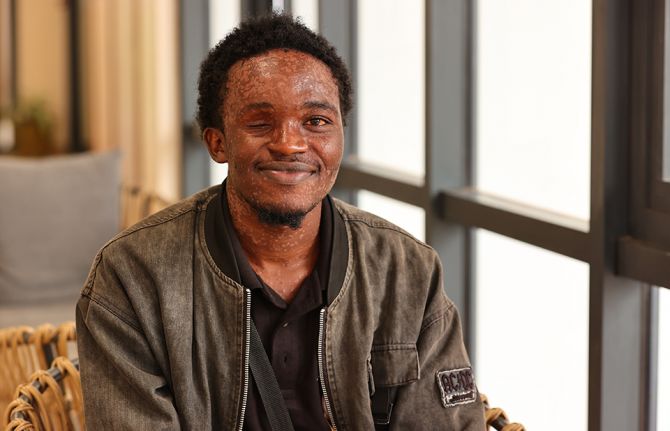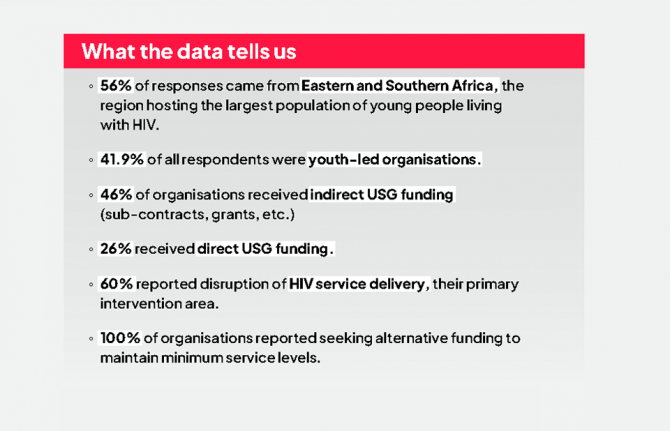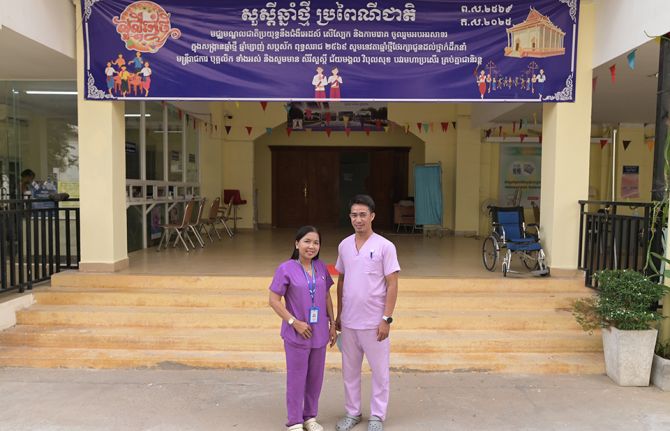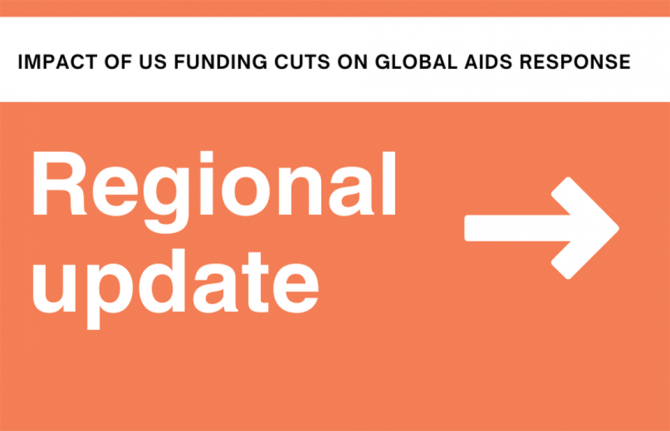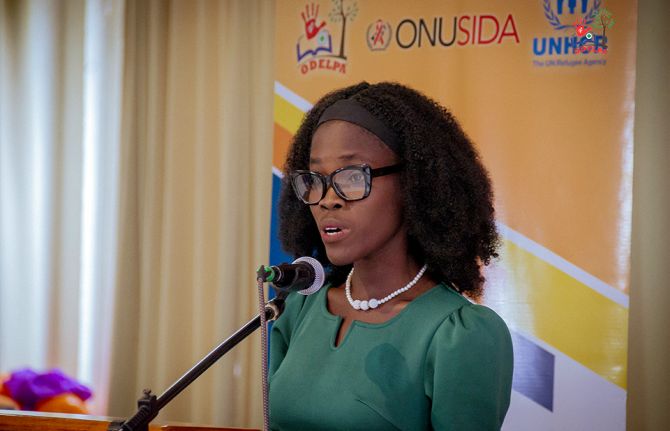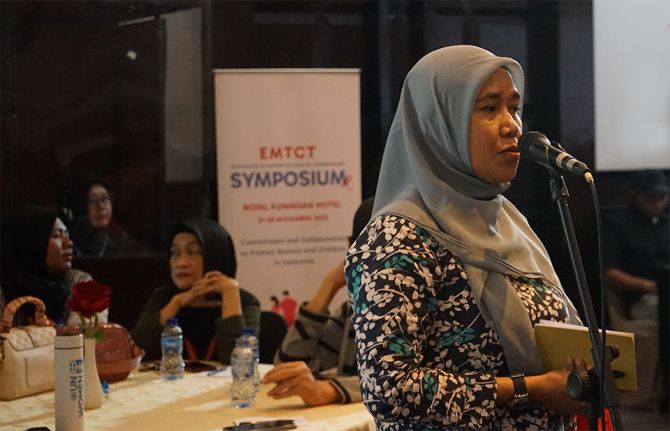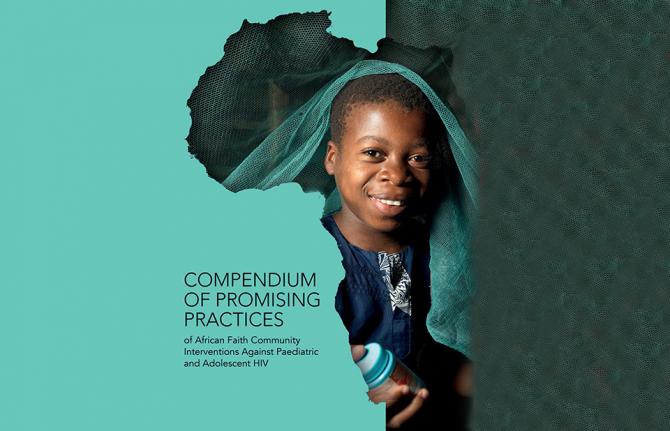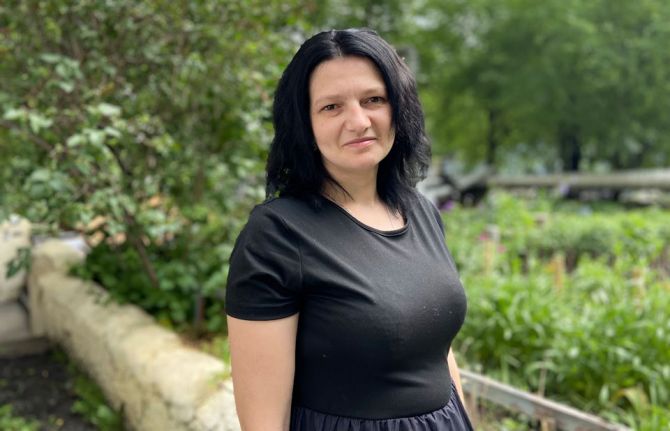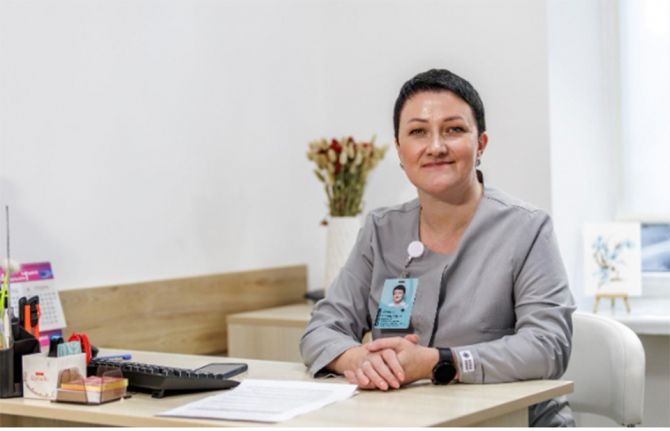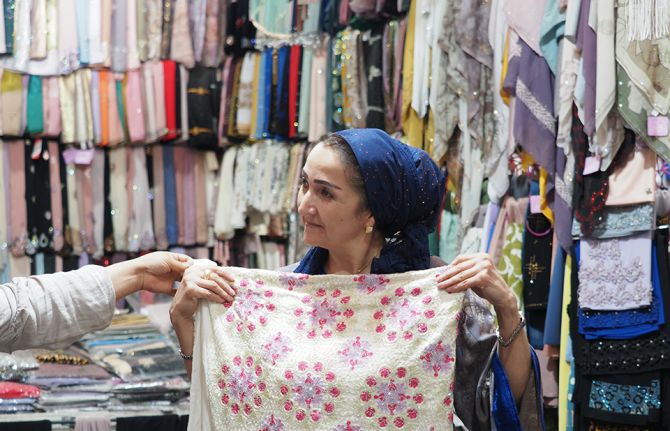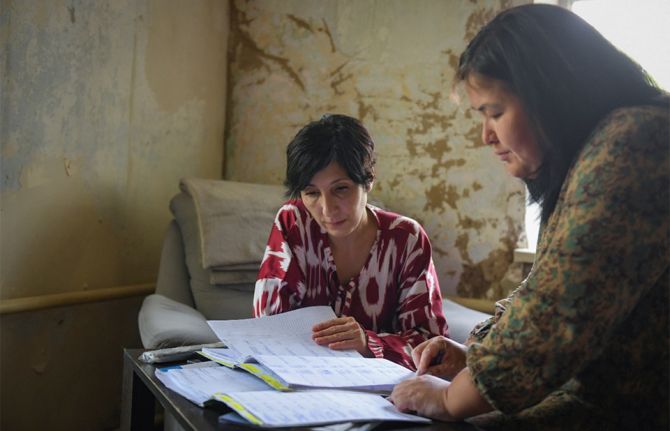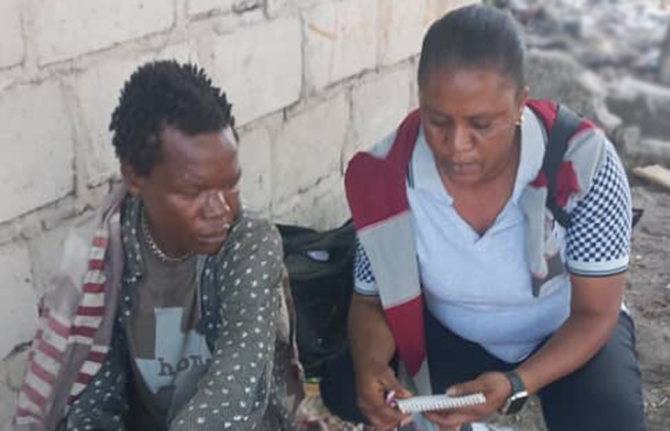
Feature Story
Innovative project in Tanzania places young people at the centre of HIV responses
06 April 2011
06 April 2011 06 April 2011
The Tanzania Youth Alliance (TAYOA) is a national, non-profit organization that empowers young people to engage in meaningful activities that improve their quality of life.
Credit: UNAIDS/AFP - Siegfried Modola
During a visit to the Tanzanian Youth Alliance (TAYOA), a national non-profit organization based in Dar Es Salaam, UN Deputy Secretary-General Dr Asha-Rose Migiro and UNAIDS Executive Director Michel Sidibé praised the young people for the extraordinary responsibility they have shown in addressing HIV.
TAYOA operates a National AIDS Helpline to respond to queries from young people on a range of HIV-related issues. Individuals call the Helpline free of charge using a landline or mobile phone. Medical students volunteer their time to counsel other youth across the country.
Starting with single phone line in 2001, the organization now runs eight lines for 12 hours a day. One thousand callers, on average, are counselled daily, and one million callers have been reached since 2008. Information is provided confidentially.
“Young people like you don’t want to sit around and be passive beneficiaries of programmes—they want to be dynamic agents of change!” said Mr Sidibé, addressing an audience of more than 200 youth at TAYOA headquarters. “What you are doing here to create space for young people is truly inspirational,” he added.
TAYOA’s National Helpline is the result of a unique public-private partnership between the Government of Tanzania, the United States Centers for Disease Control and six national phone operators: TiGO, Vodacom, Airtel, TTCL, Sastel and Zantel.
Young people like you don’t want to sit around and be passive beneficiaries of programmes, they want to be dynamic agents of change!
UNAIDS Executive Director Michel Sidibé
“In an era of real-time communications, this kind of strategic partnership is the lifeblood of effective HIV responses,” said the UN Deputy Secretary-General, after touring the TAYOA grounds. “I salute the young people who are working on this impressive project,” she added.
According to TAYOA staff, callers ask a range of questions around condom use, sexual relationships, HIV testing, antiretroviral treatment and the prevention of HIV transmission from mother to child. More than 200 young people support the National AIDS Helpline and other TAYOA programmes, including youth outreach clubs and an information technology project.
“One of the great lessons we have learned in our journey is the need to embrace and cultivate a culture of volunteerism in our society,” said Peter Masika, Country Director for TAYOA. “We have learned that when young people are meaningfully engaged, they can take charge and act to improve their own quality of life, and the lives of their friends.”
Over the past decade, young people in Tanzania appear to have adopted safer sexual behaviours: according to a UNAIDS study, HIV prevalence among Tanzanian youth aged 15 to 24 fell by more than 25% between 2001 and 2009.
Related

Feature Story
Improving access to quality and affordable drugs in Africa: The role of the International Conference on Local Pharmaceutical Production in Africa and the launch of the Southern African Generic Medicines Association
06 April 2011
06 April 2011 06 April 2011
Credit: UNAIDS
In developing countries one of the major challenges for universal access to treatment is access to affordable commodities. Two events in Cape Town are giving an opportunity for discussion, reflection and developing a strategy for improving access to quality and affordable drugs in Africa.
The International Conference on local pharmaceutical production in Africa is taking place 4-6 April 2011. Bringing together politicians, the pharmaceutical industry and development partners it’s an opportunity for exchange and collaboration—which is essential for promoting local pharmaceutical production. Under discussion are a wide range of issues including access to essential medicines, intellectual property rights, technology transfer as well as the use of TRIPS-flexibilities and the harmonization of drug regulation.
Representatives from the regional intergovernmental organizations the East African Community and the Southern African Development Community are being joined by representatives from the Indian pharmaceutical industry, as well as UNDP and WHO. They were welcomed by Stefano Bologna, UNIDO Representative; Mr Dieter Haller, German Ambassador to Pretoria; and Mr Olajide, from the African Union Commission. Participants also include Mr Anand Grover, UN Special Rapporteur on the Right to Health, and Ms Ellen T’Hoen executive director of the Medicines Patent Pool.
Building regulatory capacity is also critical to facilitate timely access to quality, safe and efficacious medicines
Dr Paul De Lay, UNAIDS Deputy Executive Director, Programme
In his keynote address at the opening, UNAIDS Deputy Executive Director, Programme Paul De Lay said that local production of high-quality pharmaceuticals in Africa is an opportunity to sustain the AIDS response over the longer term and put products nearer to those who need them.
“But it requires a strong regulatory environment that can attract private sector investments for the manufacture of medicines within Africa. Domestic production could flourish, just as we have seen in Asia and Latin America,” he said.
“Building regulatory capacity is also critical to facilitate timely access to quality, safe and efficacious medicines,” Dr De Lay added.
Southern African Generic Medicines Association launched
The conference was preceded on 4 April by the public launch of the Southern African Generic Medicines Association (SAGMA). This non-profit association hopes to promote collaboration within the pharmaceutical sector in order to achieve self-sufficiency and reliability in the local production and provision of affordable, efficacious, quality generic medicines in the Southern Africa Development Community.
UNAIDS Deputy Executive Director, Programme Paul De Lay gave one of the keynote speeches at the launch. He spoke of the power of a “pan-African vision and regulatory system” emerging, which would allow for fewer delays in authorisation of medicines, better quality control, stronger support to innovation and a more sustainable response to HIV.
“SAGMA has an essential role to play in supporting the development of a pharmaceutical regulatory plan for Africa that will support universal access to treatment,” said Dr De Lay.
Dr De Lay went on to describe how SAGMA could support countries with “implementation of TRIPS, innovative licensing schemes and the Medicines Patent Pool to keep prices going down and ensure that new generations of good quality drugs become available.”
Ms Joy Phumaphi the Executive Secretary of the African Leaders Malaria Alliance (ALMA) in Botswana, also gave a keynote address. ALMA is an alliance of African Heads of State and Government working to end malaria-related deaths. It was founded by the leaders in order to use their individual and collective power across country and regional borders.
Two panel discussions were also held to share experiences about pharmaceutical manufacturing in southern Africa. Speakers included representatives from private sector pharmaceutical companies.
External links
Speeches
Speeches
- Keynote address at launch of SAGMA (4 April 2011)
- Keynote address at International Conference on local pharmaceutical production in Africa (4 April 2011)
Related

Feature Story
Joint mission highlights successes and challenges in Tanzania’s AIDS response
05 April 2011
05 April 2011 05 April 2011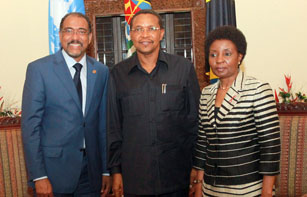
UNAIDS Executive Director Michel Sidibé (left), Tanzanian President Jakaya Mrisho Kikwete (centre) and UN Deputy Secretary-General Dr Asha-Rose Migiro at the State House in Dar Es Salaam on 4 April 2011.
In a joint mission to the United Republic of Tanzania, UN Deputy Secretary-General Asha-Rose Migiro and UNAIDS Executive Director Michel Sidibé met with high-level government officials on Monday, including the President, Prime Minister, Minister of Health and Social Welfare, and head of the Tanzania Commission for AIDS (TACAIDS).
“Through strong leadership and political will Tanzania has had great success in its response to HIV,” said Dr Asha-Rose Migiro, in a meeting with President Jakaya Mrisho Kikwete at the State House in Dar Es Salaam.
An estimated 52% of people in Tanzania who need antiretroviral treatment are now receiving it, up from virtually zero coverage in 2004. Coverage of services to prevent mother-to-child transmission of HIV reached 70% in 2010, up from 10% coverage in 2004.
Through strong leadership and political will, Tanzania has had great success in its response to HIV
UN Deputy Secretary-General Dr Asha-Rose Migiro
“I want your legacy to be zero new HIV infections among children by the year 2015,” said Mr Sidibé, in his meeting with President Kikwete. “I want Tanzania to be one of the first countries to eliminate HIV transmission from mother to child,” he added.
President Kikwete underscored that HIV was a high priority in the country. However he expressed concerns over sustainability of the AIDS response, particularly in the context of the global economic downturn. To address these concerns, the government recently created an AIDS Trust Fund with the aim of reducing the national funding gap for AIDS.
Mr Sidibé echoed the President’s concerns over the lack of predictable and long-term funding for HIV responses. About 96% of people on HIV treatment in the African continent are currently funded through external sources, he said. Mr Sidibé urged Tanzanian authorities to lead a debate at this year’s General Assembly High Level Meeting on AIDS over country ownership of HIV responses.
Related

Feature Story
Human rights and “zero discrimination” critical for future of the AIDS response in the Caribbean
01 April 2011
01 April 2011 01 April 2011
(L to R): UNAIDS Deputy Executive Director, Management and External Relations, Ms Jan Beagle; Hon Rodger Samuel, Minister in the Office of the Prime Minister responsible for HIV; Dr Ernest Massiah, Director, UNAIDS Caribbean; Mr Sam Condor, Deputy Prime Minister and Minister of Foreign Affairs of St Kitts and Nevis; Mr Ainsley Reid, GIPA, Jamaica; Ms Angelica Hunt, Ag UN Resident Coordinator; and Ms Izola Garcia, UNAIDS Coordinator for Trinidad and Tobago.
Representatives from government, civil society, people living with HIV, UN agencies and development partners from across the Caribbean met in Port of Spain, Trinidad and Tobago, to review progress made towards achieving universal access to HIV prevention, treatment, care and support targets. The two-day meeting held from 23-24 March was convened by UNAIDS in collaboration with partners in the lead up to the UN High Level Meeting on AIDS, which will take place in June 2011.
“This is a unique opportunity for everyone who is part of the AIDS response day after day to reflect and take stock of where we are on our shared journey,” said UNAIDS Deputy Executive Director, Management and External Relations, Jan Beagle.
Political leaders were candid about the challenges and underscored the need to engage young leaders and do things differently as the AIDS response enters a new era and moves towards reaching zero new infections, zero discrimination, and zero AIDS-related deaths.
“Fear, denial, ignorance, stigma and discrimination are still very prominent in the region. It is a barrier to condom use, even accessing HIV treatment and care,” said Rodger Samuel, Minister in the Office of the Prime Minister, Trinidad and Tobago. “The old approaches do not seem to be working, especially with the new generation. If we do not get our youth involved, ‘getting to zero’ will be an immensely hard task.”
There are an estimated 260 000 people living with HIV in the Caribbean. Close to half of people in need of antiretroviral treatment are receiving it. Overall, HIV now affects more women than men in the region. However, there is considerable variation between countries. For example, 60% of people living with HIV in the Bahamas are women. But in Cuba and Suriname, 69% of people living with HIV are men. AIDS remains the leading cause of death in people aged 20-59 years old.
Participants acknowledged important progress in the region to date, including a 43% reduction in AIDS-related mortality between 2001 and 2008, and an 18% reduction in new HIV infections among children during the same time period. There has been significant expansion of programmes to prevent mother-to-child HIV transmission of HIV, with four countries that reaching 95% coverage.
But stigma and discrimination, homophobia and a punitive legal environment continue to undermine efforts to reach universal access goals towards HIV prevention, treatment, care and support across the Caribbean. There are 11 countries in the region that criminalize sex between people of the same sex, and 13 that criminalize sex work. Five countries, territories and areas continue to impose restrictions on the entry, stay and residence of people living with HIV.
We must remove punitive laws that are blocking access to critical HIV services. The law should work for the HIV response, not against it
Ms Jan Beagle, UNAIDS Deputy Executive Director, Management and External Relations
“The HIV response shines a spotlight on inequality and violations of human rights, and compels us to act,” said Ms Beagle. “We must remove punitive laws that are blocking access to critical HIV services. The law should work for the HIV response, not against it.”
Participants also discussed the need to increase investment in stigma and discrimination reduction programmes to secure the rights of people living with HIV. Ainsley Reid, Coordinator for the Greater Involvement of People Living with HIV, Jamaica, underscored this by highlighting that “people living with HIV need more than medicines.”
“I know people who have died with the medicines in their hands. What we really need is social protection, including food, employment, housing, etc. This is what it takes to move beyond ‘victim mode’ and have empowerment and meaningful involvement,” he added.
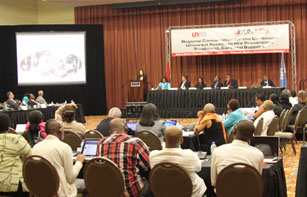
Participants during the universal access consultation that took place in Port of Spain, Trinidad and Tobago. 23-24 March 2011
Civil society reported on the outcomes and conclusions of a one-day meeting which they held prior to the universal access consultation. Representatives called for the removal of punitive laws that block HIV responses and violate human rights. The need for intensified political and community action to take on the continued taboo around issues related sexuality was also stated. Civil society also emphasized the need to train healthcare workers on ethics and confidentiality. A call was made for regional negotiations to drive down the price of medicines.
Changes in the development environment, including signs of reductions in funding flows, was a backdrop to the discussions during the two days. During the last decade the Caribbean region received more than US$ 1.3 billion in external funding for HIV. While some countries already fund their national HIV programmes entirely from domestic resources, others will be under increasing pressure to reduce programme delivery costs and secure new resources as current sources of funding decline.
“It will be imperative to clearly identify where we can make efficiencies in the region, and be ruthlessly honest about dropping what doesn’t yield us results,” said Ernest Massiah, Director of the UNAIDS Regional Support Team for the Caribbean in his remarks during the opening ceremony.
Related

Press Release
UN Secretary-General outlines new recommendations to reach 2015 goals for AIDS response
31 March 2011 31 March 2011In lead-up to June High Level Meeting, progress report presents overview of efforts needed to help countries achieve universal access to HIV services and zero new HIV infections, discrimination and AIDS-related deaths
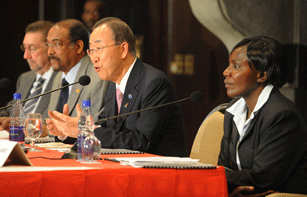
Launch of the Report of the Secretary-General. Nairobi, Kenya, 31 March 2011.
Credit: UNAIDS/AFP - S.Maina
NAIROBI, 31 March 2011—Thirty years into the AIDS epidemic, investments in the AIDS response are yielding results, according to a new report released today by United Nations Secretary-General Ban Ki-moon. Titled Uniting for universal access: towards zero new HIV infections, zero discrimination and zero AIDS-related deaths, the report highlights that the global rate of new HIV infections is declining, treatment access is expanding and the world has made significant strides in reducing HIV transmission from mother to child.
Between 2001 and 2009, the rate of new HIV infections in 33 countries—including 22 in sub-Saharan Africa—fell by at least 25%. By the end of 2010, more than 6 million people were on antiretroviral treatment in low- and middle-income countries. And for the first time, in 2009, global coverage of services to prevent mother-to-child transmission of HIV exceeded 50%.
But despite the recent achievements, the report underscores that the gains are fragile. For every person who starts antiretroviral treatment, two people become newly infected with HIV. Every day 7 000 people are newly infected, including 1 000 children. Weak national infrastructures, financing shortfalls and discrimination against vulnerable populations are among the factors that continue to impede access to HIV prevention, treatment, care and support services.
The Secretary-General’s report, based on data submitted by 182 countries, provides five key recommendations that will be reviewed by global leaders at a UN General Assembly High Level Meeting on AIDS, 8–10 June 2011.
“World leaders have a unique opportunity at this critical moment to evaluate achievements and gaps in the global AIDS response,” said Secretary-General Ban Ki-moon at the press briefing in the Kenyan capital. “We must take bold decisions that will dramatically transform the AIDS response and help us move towards an HIV-free generation.”
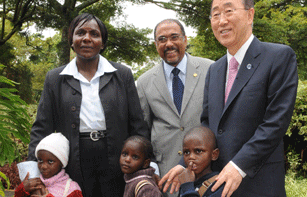
United Nations Secretary-General Ban Ki-moon and UNAIDS Executive Director Michel Sidibé with Rebecca Auma Awiti, mother of three children and field coordinator with the non-governmental organization Women Fighting AIDS in Kenya who told her story at the press conference.
Credit: UNAIDS/AFP - S.Maina
“Thirty years into the epidemic, it is imperative for us to re-energise the response today for success in the years ahead,” said UNAIDS Executive Director Michel Sidibé, who joined Mr Ban for the launch of the report. “Gains in HIV prevention and antiretroviral treatment are significant, but we need to do more to stop people from becoming infected—an HIV prevention revolution is needed now more than ever.”
Rebecca Auma Awiti, a mother living with HIV and field coordinator with the non-governmental organization Women Fighting AIDS in Kenya told her story at the press conference. “Thanks to the universal access movement, my three children were born HIV-free and I am able to see them grow up because of treatment access,” she said.
Mobilizing for impact
In the report there are five recommendations made by the UN Secretary-General to strengthen the AIDS response:
- Harness the energy of young people for an HIV prevention revolution;
- Revitalize the push towards achieving universal access to HIV prevention, treatment, care and support by 2015;
- Work with countries to make HIV programmes more cost effective, efficient and sustainable;
- Promote the health, human rights and dignity of women and girls; and
- Ensure mutual accountability in the AIDS response to translate commitments into action.
The Secretary-General calls upon all stakeholders to support the recommendations in the report and use them to work towards realizing six global targets:
- Reduce by 50% the sexual transmission of HIV—including among key populations, such as young people, men who have sex with men, in the context of sex work; and prevent all new HIV infections as a result of injecting drug use;
- Eliminate HIV transmission from mother to child;
- Reduce by 50% tuberculosis deaths in people living with HIV;
- Ensure HIV treatment for 13 million people;
- Reduce by 50% the number of countries with HIV-related restrictions on entry, stay and residence; and
- Ensure equal access to education for children orphaned and made vulnerable by AIDS.
As international funding for HIV assistance declined for the first time in 2009, the report encourages countries to prioritize funding for HIV programmes, including low- and middle-income countries that have the ability to cover their own HIV-related costs. It also stresses the importance of shared responsibility and accountability to ensure the AIDS response has sufficient resources for the coming years.
The report and more information about the High Level Meeting on AIDS can be found online at: unaids.org/en/aboutunaids/unitednationsdeclarationsandgoals/2011highlevelmeetingonaids/
Contact
UNAIDS GenevaSophie Barton-Knott
tel. +41 22 791 1697
bartonknotts@unaids.org
UNAIDS Nairobi
Saira Stewart
tel. +41 79 467 2013
stewarts@unaids.org
UNAIDS Nairobi
Esther Gathiri-Kimotho
tel. +254 20 762 6718
gathirikimothoe@unaids.org
UN Department of Public Information New York
Vikram Sura
tel. +1 212 963 8274
sura@un.org
UN Department of Public Information New York
Pragati Pascale
tel. +1 212 963 6870
pascale@un.org
External links
External links
Press centre
Download the printable version (PDF)

Feature Story
Top 30 medicines to save mothers and children identified by the World Health Organization
29 March 2011
29 March 2011 29 March 2011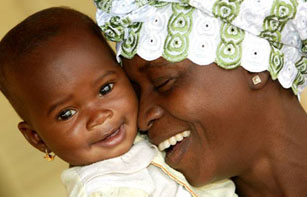
Credit: UNAIDS/P. Virot
The World Health Organization (WHO) has published its first ever list of 30 priority medicines for maternal and child health. The list includes medicines for children living with HIV as well as a triple combination of drugs to prevent mother-to-child transmission of HIV.
Compiled by experts in maternal and child health and medicines, the list is based on the WHO Model List of Essential Medicines and the latest WHO treatment guidelines. It provides a concrete way forward in striving to achieve global health goals[i].
The health situation for many women and children across the globe remains precarious. Despite a decline since 2004, in 2009 an estimated 260 000 children under the age of 15 died from AIDS-related illness[ii]. Every day some 1000 women lose their lives due to complications during pregnancy and childbirth. Most of these deaths can be prevented if the correct medicines in the correct formulations are prescribed and used in the correct way.
Many of the medicines can be administered quickly and easily. For example, a single injection of oxytocin can stop a woman bleeding to death if she haemorrhages after childbirth.
Preventing mother-to-child transmission of HIV
The WHO-recommended drug regimen of prolonged use of combination of three antiretroviral (ARV) drugs to prevent mother-to-child transmission of HIV is also highlighted in the priority medicines list.
Positive results from a WHO-led study that were published in The Lancet in January 2011 showed that giving pregnant women living with HIV a combination of three ARV drugs during the last trimester of pregnancy, through delivery and six months of breastfeeding can reduce the risk of their baby being infected with HIV by more than 40% compared to the use of a single-dose ARV drug regimen which stopped at delivery as had been recommended by WHO since 2004.
Children and HIV
Without effective HIV treatment, an estimated one third of infants living with the virus will have died by one year of age, and about half will have died by two years of age. The list includes recommendations in the area of paediatric AIDS. Appropriate doses of the right combinations of antiretrovirals are critical to reducing child deaths from AIDS-related illness.
According to WHO, additional research and development is also urgently needed for appropriate products for prevention and treatment of tuberculosis, particularly in children living with HIV.
This list is designed to help countries prioritize, so that they focus on getting the most critical things available and save the most lives
Dr Elizabeth Mason, Director of WHO's Department of Maternal, Newborn, Child and Adolescent Health
Despite these pressing needs, surveys conducted in 14 African countries show that children's medicines are available in only 35% to 50% of pharmacies and drug stores[iii]. There is also a lack of awareness that children need different medicines from adults. When adult medicines are fractioned into smaller parts for children, the dose can be inaccurate and the medicine hard to swallow.
WHO recommends that, wherever possible, medicines for children should be provided in doses that are easy to measure and easy to take. There should also be steps to ensure that medicines are appropriate for the intended setting.
"Medicines produced in liquid form are more expensive than tablets or powders and are also more difficult to store, package, and transport, due to their bulk, weight and need for refrigeration. The list we have drawn up tells manufacturers exactly what they should be producing to meet countries’ needs," said Dr Hans V. Hogerzeil, Director of WHO's Department for Essential Medicines and Pharmaceutical Policies.
The release of the list of top 30 medicines to save mothers and children was timed to coincide with the meeting of the 18th Expert Committee on the Selection and Use of Essential Medicines. The meeting took place in Ghana, 21-25 March 2011. “This list is designed to help countries prioritize, so that they focus on getting the most critical things available and save the most lives," said Dr Elizabeth Mason, Director of WHO's Department of Maternal, Newborn, Child and Adolescent Health.
[i] Millennium Development Goals 4, 5 & 6: Reduce child mortality; Improve maternal health; Combat HIV/AIDS, malaria and other diseases.
[ii] UNAIDS global report 2010
[iii] Jane Robertson, Gilles Forte, Jean-Marie Trapsida & Suzanne Hill. What essential medicines for children are on the shelf? Bulletin of the World Health Organization 2009;87:231-237. doi: 10.2471/BLT.08.053645
External links
Publications
Related

Feature Story
North Star Alliance road show highlights work of its network of mobile clinics along transport corridors in Africa
29 March 2011
29 March 2011 29 March 2011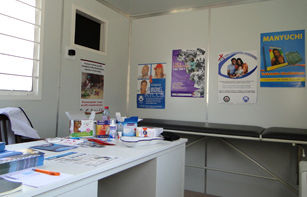
A 40-foot converted shipping container making its way around European cities is vividly highlighting the work of North Star Alliance. Credit: UNAIDS
A 40-foot converted shipping container making its way around European cities is vividly highlighting the work of North Star Alliance. This public-private partnership is committed to building a network of roadside clinics at transport ‘hotspots’ in Africa to provide long-haul truck drivers, sex workers and surrounding communities with access to basic health care.
This week the North Star Alliance road show, with its container-based model wellness centre, arrived in Geneva. UNAIDS and World Health Organization staff were able to see for themselves exactly how these centres operate. Many took advantage of the opportunity to receive free medical checks, including blood pressure testing.
From HIV prevention to antihistamines
This is one of the best public-private partnerships I’ve seen. It works well. Each partner brings specialist expertise and knowledge to make a strong and cohesive intervention that’s really making a difference
Robin Jackson, UNAIDS’ representative on the board of North Star
The broad range of services on offer in a typical wellness centre includes condom distribution, treatment for sexually transmitted infections, information on HIV prevention and nutrition, basic eye tests, malaria treatment and even getting antihistamines for the common cold. Most centres also offer HIV counselling and testing and access to a behaviour change communication specialist. North Star is planning to expand its services to include greater support for antiretroviral therapy and tuberculosis screening.
There are now 22 wellness centres in 10 countries in east and southern Africa. By the end of 2014 there will be 100 such centres covering 85% of the major transport corridors on the continent.
In the field, the shipping containers are placed at border posts or transit towns where truckers congregate and are open late, when drivers have parked for the night and sex work tends to take place. In general mobile workers, who often have to spend long periods away from their families, may have multiple partners and use the services of sex workers.
A model partnership

A broad range of services are on offer including condom distribution, treatment for sexually transmitted infections, information on HIV prevention and nutrition, basic eye tests, and malaria treatment. Credit: UNAIDS
North Star Alliance is an independent non-governmental organization, supported by five core partners: the express distribution company TNT, the International Transport Workers’ Federation, the World Food Programme, UNAIDS and ORTEC, a large provider of logistics software. It is seen as a model of public-private partnership.
According to Robin Jackson, UNAIDS’ representative on the board of North Star; “This is one of the best public-private partnerships I’ve seen. It works well. Each partner brings specialist expertise and knowledge to make a strong and cohesive intervention that’s really making a difference. ”
External links
Related

Feature Story
Investment in HIV prevention among key populations and scale up of HIV treatment coverage key to universal access in Eastern Europe and Central Asia
29 March 2011
29 March 2011 29 March 2011
Minister of Heath of Kyrgyzstan, Sabyrbek Dzhumabiekov (left) and, UNAIDS Deputy Executive Director, Programme, Paul De Lay addressing participants at the universal access consultation. Kiev, 17-18 March 2011
Insufficient investment in programmes to prevent HIV infection among key populations at higher risk is hampering efforts to achieve universal access to HIV prevention, treatment, care and support in Eastern Europe and Central Asia. That’s according to participants at the regional consultation that took place in Kiev, Ukraine on 17-18 March 2011.
Government and civil society representatives from 30 countries across the region participated in the universal access consultation. The objective was to discuss gaps in the region’s response to HIV as well as identify key priorities for future action.
“Eastern Europe and Central Asia remain far from achieving universal access, in spite of significant efforts,” said Dr Denis Broun, Director, UNAIDS Regional Support Team, Europe and Central Asia.
The region has seen progress in preventing mother-to-child HIV transmission. HIV treatment coverage has been slowly increasing in recent years. Yet only one out of four people needing treatment are receiving it—the lowest coverage rate in the world.
Insufficient availability of treatment as well as prevention programmes—especially for the key populations at higher risk of HIV such as people who use drugs, men who have sex with men, prisoners and sex workers—were seen as the major gaps in the region leading to the increase of new infections.
Eastern Europe and Central Asia remain far from achieving universal access, in spite of significant efforts
Dr Denis Broun, Director, UNAIDS Regional Support Team, Europe and Central Asia.
One of the discussions centred around the significant dependence that the region has on international financial support, specifically in the form of Global Fund grants. Participants stressed that national funding levels were low and called for countries to increase their domestic investment in the AIDS response. “Countries should not wait until funding from the Global Fund and other international donors ends. Sustainability of the HIV prevention, treatment, care and support should rely on national budgets,” stated participants in their final recommendations. “Governments should look at AIDS funding not as ‘spending’ but as investing in the economy, in the workforce and the future."
Representatives of non-governmental organizations noted that, in general, civil society is not involved in budgetary decision-making when it comes to allocation of government funds. As a consequence, the effectiveness of the overall AIDS response remains low due to the limited capacity of the State to respond to the needs of people at higher risk of infection.
According to participants, there is a lack of sufficient HIV prevention programmes providing information to young people, raising awareness and promoting condom use to prevent sexual transmission of HIV. The existence of HIV-related travel restrictions, criminalization of HIV transmission and same-sex relations and the repressive police practices towards people who inject drugs were identified as significant barriers to establishing relationships of trust with people most-at-risk. Participants also agreed on the need to create legal environments to facilitate the intake of HIV prevention services by populations at higher risk of infection.
The recommendations made by participants will be included in the universal access progress report that will be presented at the United Nations General Assembly High Level Meeting on AIDS that will take place in New York in June 2011.
“The HIV situation in the region is critical. By contributing to the recommendations at a time when they are developed, we have a chance to ensure that the voice of people living with HIV is heard,” said Vladimir Zhovtyak, head of the Eastern European and Central Asia Network of People Living with HIV.
Related

Feature Story
Investment in health is an investment in economic development
29 March 2011
29 March 2011 29 March 2011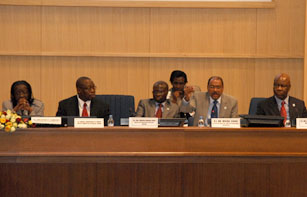
(from left) Advocate Bience Gawanas, Commissioner of Social Affairs at the AUC, Addis Ababa, Ethiopia; Mr Robert Joseph Mettu Mumoo, Deputy Minister of Health Ghana; Mr Modoul Diagne Fada, Minister of Health and Prevention, Senegal; Mr Michel Sidibé, UNAIDS Executive director; Mr Essimi Menye Lazare, Minister of Finance, Yaoundé, Cameroon. Credit: UNAIDS
African Ministers of Finance and Health came together in Addis Ababa on 29 March 2011 for a high level panel discussion to explore new ways of investing in health.
The panel, entitled More health for money and more money for health, was part of the 4th Joint Annual Meetings of the African Union Conference of Ministers of Economy and Finance and ECA Conference of African Ministers of Finance, Planning and Economic Development.
The discussion aimed to foster dialogue on health financing to improve health outcomes to help accelerate achievement of the health-related Millennium Development Goals. Ministers of Finance and Economic Development from Sierra Leone and Cameroon joined Ministers of Health from Ghana and Senegal as well as the Executive Directors of UNAIDS and UNFPA.
“Investing in AIDS is not only the right thing to do, but the smart thing to do,” said UNAIDS Executive Director Michel Sidibé. “Thanks to smart investments, more than four million Africans now benefit from HIV treatment, living resourceful, productive lives and raising solid families,” he continued. “And because we have invested in HIV prevention strategically over the past decade, the rate of new infections has dropped by more than one-quarter in 22 African countries,” he added.
Investing in AIDS is not only the right thing to do, but the smart thing to do. Thanks to smart investments, more than four million Africans now benefit from HIV treatment, living resourceful, productive lives and raising solid families
Michel Sidibé, UNAIDS Executive Director
Development assistance to health more than doubled with the emergence of The Global Fund to Fight AIDS, Tuberculosis and Malaria, the Global Alliance for Vaccines and Immunization (GAVI), the Bill & Melinda Gates Foundation and recently, the International Health Partnership. This progress in health financing has contributed to improvements in child health, HIV, tuberculosis and malaria.
While some improvement has been made in health outcomes in parts of the Africa continent, progress is still limited and unequally distributed both among and within countries.
Abuja commitments on health financing not being met
In 2001, African Heads of State and Government made financial commitments towards meeting the Millennium Development Goals by pledging to allocate at least 15% of their national budgets to health. These pledges remain largely unmet, as only six out of 53 African States have achieved the Abuja commitments on health financing.

(from left) Donald Kaberuka, President of African Development Bank and Michel Sidibé, UNAIDS Executive Director. Credit: UNAIDS
Moreover, some 32 of the 53 Africa Union (AU) member States still invest less than half the WHO-recommended US$ 40 per person. Eleven of these countries are investing about US$ 5 per person, an amount too low to tackle diverse health challenges and strengthen health systems.
Participants at the panel discussion concluded that investment in health is an investment in economic development. It was agreed that a key element for sustainable economic development is long-term investment in human, health and social development.
As part of his participation at the conference, Mr Sidibé also met with Mr Donald Kaberuka, President of the African Development Bank. They agreed to explore and support innovative sustainable mechanisms for funding the AIDS response on the African continent.
Related

Feature Story
Commission on Narcotic Drugs adopts resolution on scaled up HIV prevention among people who use drugs
28 March 2011
28 March 2011 28 March 2011
United Nations in Vienna
Credit: UN
The fifty-fourth session of the United Nations Commission on Narcotic Drugs (CND) has adopted a resolution on Achieving zero new infections of HIV amongst injecting and other drug users.
The CND noted the 2011-2015 UNAIDS Strategy which promotes the objectives of achieving zero new HIV infections, zero AIDS-related deaths and zero stigma and discrimination. UNODC was requested to continue providing advice and guidance on effective measures to scale up HIV prevention for people who use drugs, and on how to reduce stigma and discrimination.
The Commission also reaffirmed the central importance of civil society as a key partner in the global response to HIV, including to achieving the vision of zero new HIV infections. Member States were urged to ensure their political commitment to the HIV response, by highest level participation in the UN General Assembly High Level Meeting on AIDS which will take place in New York 8-10 June 2011.
A statement was delivered to the CND on behalf of UNAIDS by Michael Bartos, Team Leader, Strategy Support and Evaluation. UNAIDS’ strategy goal of preventing all new HIV infections among people who use drugs was highlighted. “Despite major gaps in programme efforts directed to this goal, real country results in preventing HIV transmission among drug users suggest that where programmes are delivered at scale, achieving this ambitious goal is possible.”
HIV and injecting drug use
Globally, there are an estimated three million people who inject drugs also living with HIV—with nearly 13 million more at risk of HIV infection. While access to HIV prevention services, including harm-reduction programmes has increased, in 2009 the median coverage of HIV prevention services was 32%.
Commission on Narcotic Drugs
The Economic and Social Council established the Commission on Narcotic Drugs (CND) in 1946 as the central policy-making body of the United Nations in drug-related matters. CND enables Member States to analyse the global drug situation, provide follow-up to the General Assembly and to take measures at the global level within its scope of action. It also monitors the implementation of the three international drug control conventions and is empowered to consider all matters pertaining to the aim of the conventions, including the scheduling of substances to be brought under international control.

